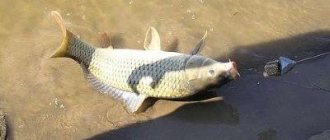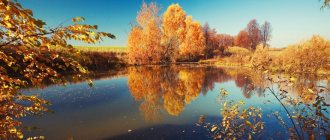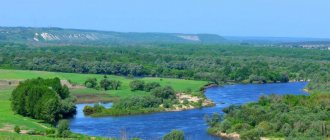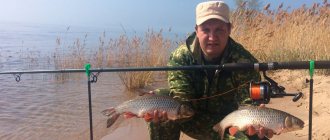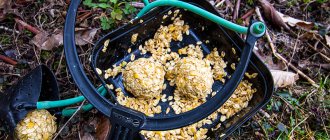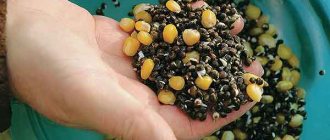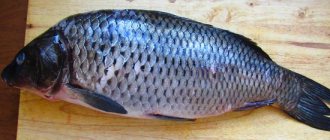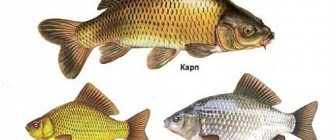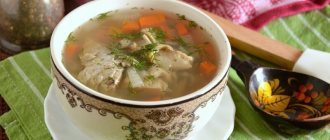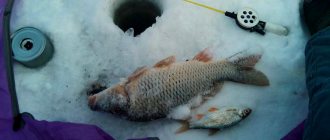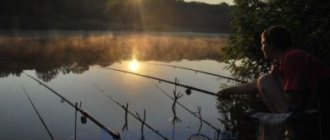Fishing on the Don in August it's just fun. Firstly, you can fish here and secondly, just relax.
A real paradise for the amateur fisherman. Moreover, August contributes to this in the best possible way. The heat subsides, there is no stuffiness, and there are much fewer insects.
For fishing on the Don in August there is simply plenty. There is plenty of fish here.
In the Don and its tributaries you can find sazai, bream, pike perch, ide, chub, podust, bluefish, perch, pike, burbot, sabrefish, weasel, gobies, minnows, ruffe, bleak, rudd, tench, crucian carp, and in the Don on the rapids Sterlet is also often found. To search for fish on the Don, be sure to purchase an echo sounder.
None In this place, three tributaries flow into the Don over a length of thirty-five kilometers: at Divnogorye the Tikhaya Sosna flows, at the Gostin farmstead - Potudan, at the village of Devitsa - the Devitsa River.
Fishing on the Don in August is excellent because there are also rifts where large fish feed and pike perch hunt. And deep holes with snags, where there is a lot of catfish, bream, carp. There are also wide and quiet reaches.
In general, fishing on the Don in August simply cannot but please the true fisherman, and of course the amateur too.
If you want to know all the intricacies of fishing in August, we recommend reading after this article everything about fishing in August. This will be useful and interesting to everyone without exception.
Getting here is easy. Especially from Voronezh, Kharkov, Donbass, Moscow. Any train going in the direction Moscow - Rostov, Kharkov - Kazan will suit you.
You will need Liski station. And from there you can find a river station and from there by boat to any place on the Don. Boats run daily.
Fishing on the Don in August. We catch bream on the Don.
They really love to catch bream on the Don. On the Don, you need to look for bream in deep places with a rough bottom.
To search for such places, use an echo sounder; it will show you where the fish are and the bottom topography with all the snags and holes. The best time to catch bream on the Don is in the morning or evening. Another excellent bream fishing on the Don is at night. He leaves the sandbanks.
Bream fishing on the Don ends at the end of August, beginning of September. The best way to catch bream on the Don is to use a mayfly larva or also called a snowflake. Mayfly larva can be obtained with underwater soil. You can also use an earthworm.
How to get a mayfly larva? An ordinary shovel is best suited for this; you need to bend the side edges and place it on a 4-6 meter pole.
It is best to get larvae on steep banks. For this, of course, it is better to use a boat. Dip your shovel (it is also called: kortz-blizzard) into the underwater soil, take it all to the shore and select the larvae.
Of course, to get to deep places you will need a boat. This is the basis for real success when fishing for bream.
What about fishing on the Irtysh in August?
[custom_ads_shortcode1]
Fishing on the Don in August. We catch carp on the Don.
Another attractive catch for a fisherman will be carp. Carp on the Don reaches twenty kilograms. Which is just a great trophy.
The best time to catch carp on the Don is in the morning and evening. If the weather is cloudy, then you can catch carp all day.
It is better to catch carp with bottom fishing rods. Suitable places for catching carp on the Don are deep holes with sunken snags. And near steep, washed-out banks.
For bait, use millet porridge, mayfly larvae, worms, peas, corn, bread, and boiled potatoes. Use sunflower or hemp cake as bait.
Good luck fishing on the Don. Thank you for reading us!
Follow the updates on the website.
According to law enforcement agencies, in the area of the city of Sofia, they beat the zadarzhani Chetirim Mazhe, suspecting poaching. By the end of the day, 318 kilograms of fish were caught.
Fishing inspectors beat the study of the fact that why zadarzhanite nyamali absolutely no quality of poaching equipment (grinds, electric shocks, explosions, etc.). In response to the question, as soon as they managed to catch a lot of fish, you can immediately say “good kalvane”. But when looking at the personal items, one of the inspectors was drawn from the packaging with an alien etiquette. You ingested a spray of unknown origin
A trace of the examination has established that the substance is capable of much, much stronger influence on the effect of special enzymes. This is the main property of this substance, which was activated in response to the sensation of hunger with unprecedented strength. Over the course of the experiment, even nai-sitata fish, under the influence of the enzyme, became very active and showed an incredible appetite.
The trail was washed away, it became clear that you are truly not poachers, but amateur fisherman. One from zadarzhanite se finished off from primamkata prez internet, from one site. Samite zadarzhani beat malko shokirani, ty kato tak'v golyam catch they samite could not and they will present it. The trace is explained based on the circumstances, you can beat them without intending to have a legal basis for the delay or violation of the law.
The investigation commission was very interested in the intention of the nurse. Okazva behold, why did this remedy beat was created prez godina from the Canadian teaching. Vednaga trace is invented, the basin was added to the black list from the editors of the European countries and this was strictly prohibited until the day. In the country, this is not the law (at the moment we are preparing an appeal for registration of complaints), and thanks to the bureaucracy, the deals are all over, soon no matter what. Nie yourself on the Internet site, selling the bait absolutely legally, for the joy of all the ribari. Zasega yama bill for taken away and everything is within the framework of the law.
Share the link, love your health: Official website for sales for the FISH XXL TUK activator
In most Russian reservoirs there is a wide variety of fish, but carp, all the same, has always been and remains one of the most popular and dear to the heart of every angler. Carp is a prestigious trophy, and if you also managed to catch a large specimen, then there will be enough stories about such success for more than one year.
[custom_ads_shortcode3]
Habitats of carp
Carp live in the basins of the Caspian, Baltic, as well as the Azov and Black seas. The further south you go, the earlier you can start catching carp, since this is a heat-loving fish and does not appear in the cold season. If in the southern regions the first bite is observed in April, then in central Russia the best bite is in August, when the reservoirs have already warmed up enough, and the carp that has settled in them has finished spawning and begins to respond to food before the coming cold weather.
It is best to look for carp in warm bodies of water with stagnant water or a gentle, barely perceptible current. Ponds, lakes, reservoirs and small streams are well suited for this. Carp often lives near steep banks and pools.
[custom_ads_shortcode1]
Where and when to catch carp?
If the weather is normal for August and there are no noticeable temperature changes, the carp feeds around the clock. For a good bite, the location of the reservoir in which the carp lives and the time of day at which you go fishing are important. If you fish at night, we recommend doing it in shallow water - carp most often visits it in the dark. It is impossible to say for sure which hours are best for night fishing, but experienced fishermen know that it is useless to catch this fish from one to three in the morning. In the evening or early morning (at 4-5 o’clock) the carp often appears at the edge of the reservoir to feed on small animals that come from the shore. Carp carefully avoids places where pike, pike perch and catfish are found. After sunrise, when the reservoir begins to warm up, the carp gradually swims to the depths. At 9-10 o'clock in the morning you can catch a very good bite if you move to the northwestern sections of the coastline - to places that have already been warmed up by the sun and which carp usually visits in the morning. During the day, only small carp bite, and not always, but closer to 6 pm this fish can be caught if you fish from a boat in calm, well-warmed places. Catching carp in August has a number of features, one of them is its dependence on the weather. If there is extreme heat, despite all its heat-loving nature, the carp will not bite. He also does not like strong bad weather or sudden changes in weather. Warm, light rain or cloudy weather with rain is ideal for catching carp in August.
[custom_ads_shortcode2]
Choosing a fishing spot
The success of carp hunting depends on the correct determination of the water area. This underwater representative prefers to stop in river beds close to the bottom (at a depth of at least 3 meters), where it is not reached by water flows. Also, this type of fish can be found in holes, ditches, ruts and other bottom anomalies. They like to hide behind snags and vegetation. They are attracted to submerged tree trunks and branches in shallow water, as well as bridge pillars and piles.
For food, fish often look for places with many shells and vegetation. Large individuals are located at the edge of the water flow difference. And small fish prefer to stay quieter in the water area. On warm nights, golden beauties prefer to bask on the coastal shallows.
It is faster to search for carp with an echo sounder, where it is not very deep, but there are sharp changes in the bottom relief. There is a high probability that prey is hiding in these depressions. Also, consider areas near pools, reeds, snags and other debris. Only promising areas need to be selected in advance.
To catch carp from the coastal zone, it is advisable to install several rods at once
Groundbait and bait for carp
It is in August that the opportunity arises to catch a very large, well-fed carp. Before this, small individuals are usually caught, and in mid-late September the food disappears completely. In order to lure fish, it is best to use a mixture of wheat and millet porridge, boiling them well.
Steamed rye and buckwheat, rice, pearl barley or millet cooked in milk, any bread, cottage cheese or beans are also suitable. To attract large fish, tightly rolled balls of a mixture of hemp grain, steamed grain crops and clay are thrown. Under no circumstances should you consume grain that is already beginning to sour; fish will not go to such a place.
The bait is thrown right at the place where they are going to fish, as well as little by little into the corners of the sector and into the depths. It is best to secure a place 10-12 hours before fishing. For successful carp fishing, the bait you use is extremely important.
It is better to take several options with you, since fish often prefer one or the other. It is good to use a red dung worm for catching carp. You can choose a bait similar to bait: if you cook millet porridge so hard that it can be cut into pieces, then you can easily attach it to the hook.
Rolled tight balls from a mixture of steamed wheat grains, earthworms and bread are suitable. A real delicacy for carp is boiled crayfish necks, bread and legumes. All this can be combined with wheat flour dumplings.
[custom_ads_shortcode3]
Lures
A few grains of corn have always been considered an excellent bait for carp and carp.
Plant and animal bait is the basis for catching carp. There is a wide variety of lures, and here are the most popular ones.
- We take potatoes , preferably ones that do not fall apart after cooking. Throw it, unpeeled, into boiling salted water for about 20 minutes. Then peel the potatoes and cut them into cubes. This will be an excellent bait for carp.
- Millet porridge is good for carp. To prepare the bait, you need to take a bag of porridge and put it in the oven so that it evaporates. Then cool the porridge and cut it into squares so that they fit the hooks.
- Ripe corn kernels can be boiled in salted water and then dried. Fish like them.
- peas , especially if they are soaked for 24 hours in a soda solution and then boiled in a gauze bag for about one hour.
- Dough in the form of balls is excellent as bait for carp. For cooking you will need flour and vegetable oil. You can also add berries, vanillin or anise - their aroma has a specific effect on fish.
- various berries as bait :
- grape;
- Rowan;
- cherry;
- raspberries, etc.
They are placed on the hook so that it goes around the bone.
Store all baits in wooden boxes with holes in a cool place.
If you buy bait, then stop at boilies. There are a lot of tastes and in all bodies of water the preferences of carp are different. Start with diametrically opposed tastes - fishy and sweet. Test it.
What is the secret of catching carp
To catch carp in August, it is best to use running tackle, since the fish not only has time to gain weight, but also become quite cautious. The first jerks of the carp after it is hooked are very sharp and strong; a blind tackle on a thin line will never survive. And since the carp is cautious, it is not possible to use a thick fishing line: then bites will be extremely rare, or you may not even get them at all. As for the fishing rod, it is better to use the most powerful and durable option possible. A stiff rod will do a great job of holding back a fish's jerks without having to let out too much line. The most convenient type would be a spinning reel with a large drum. If you fish at shallow or medium depths that do not exceed the length of the rod, then it is best to use a float rod. While holding it, be careful: if the line is loose between the rod and the float, then the fish, having swallowed the bait, will not notice resistance, which will allow the hook to fix more securely. The distance to the float should be about two meters; the same amount or slightly less fishing line will be located in the water column. If you are unable to comply with these parameters, since you are fishing at depth and from a boat, you need to use two sinkers that can hold the line at the desired level.
[custom_ads_shortcode1]
Equipment for fishing for carp
Boilies are primarily used on hair rigs. It allows you to position the nozzle at some distance from the hook. Use a leash about 10 cm long. To ensure high-quality self-hooking when biting, use a heavy sinker. Some fishermen use a feeder, which acts as an additional bait when fishing for carp. A carp hook No. 6 is suitable here. The recommended length of the entire equipment is about 40 cm. The equipment is used in still water and in currents.
Boilies can have different smells
What kind of boilies should be used for carp?
The size of the boilies is determined by the size of the expected catch. To eliminate the possibility of small fish biting, the balls are made with a diameter of two or more centimeters. They will allow you to become the owner of a large specimen.
The preferences of carp are influenced by many factors:
- weather;
- season;
- water temperature;
- period of preparation for hibernation;
- preparation for throwing caviar.
Catching carp with boilies
To become the owner of a trophy carp, you will have to try
Everything is important here:
First, decide on the type of boilies. If the bottom is muddy, use a floating bait. In summer, prepare it from plant ingredients
In winter, add fishmeal and other animal ingredients.
By offering baits with different scents, you will determine which bait to use to catch carp in a particular body of water. Pay attention to the bait. Many people believe that the best bait is a handful of maggots
But experienced fishermen feed with boilies themselves. An expensive, but quite effective option will definitely please you. Nozzle quality. If you are unable to make high-quality boilies, it is better to use store-bought ones.
Animal baits for carp
Boilies are not the only type of bait for carp. Under certain circumstances, fish prefer baits of animal origin:
- Maggots are among the most common baits when fishing for many types of fish. Fly larvae give good results. Growing them yourself is not difficult. But it is much easier to purchase them;
- Larger worms are selected. They will allow you to hope for a good catch. Crawlers, earthworms and dung worms are suitable here;
- The cockchafer appears in the last month of spring. It is placed in the chest area. Tear off the wings first;
- shellfish meat. Mollusks are natural inhabitants of water bodies. Habitual food is a real delicacy for carp and other fish species. Free it from the shell and cut it into several pieces. The pieces are put on a hook.
Due to the fact that the described fish species is considered omnivorous, bait can be made from various ingredients
Plant baits for carp
Plant baits in summer give positive results:
- dough. Its preparation begins with kneading the flour. To increase the attractiveness of the bait, butter, sugar, berries, eggs and various flavors are added;
- bread. Its soft part is used when fishing for crucian carp. But add vegetable oil, flour, boiled potatoes and fruit flavors. You will get an excellent bait for carp;
- porridge. Mash the cooked millet. To prevent the mixture from crumbling, place it in the oven. Then the porridge is cut into cubes of suitable sizes;
- corn and peas are classic baits. They are soaked in water and cooked until they have a soft texture. There are recipes where the attachments are infused for about a month. During this period, the peas soak, acquiring suitable softness. The canned product also shows good results. In some situations, carp prefers peas and corn from a can;
- potato. Choose a variety that doesn't cook well. To obtain better firmness, potatoes are boiled with their skins on. Balls resembling boilies are cut from boiled tubers.
Using berries when fishing for carp
Beginner fishermen use exclusively classic baits. But under certain circumstances, fish react to various berries. In spring, use raspberries, cherries, and cherries. In the fall, offer the fish grapes and other berries. The fish will not pass by the fruit bait. The berries have a natural, attractive aroma. There is no need for additional use of flavorings here.
Does the carp bite or not?
It is usually quite simple to determine that a carp is biting. The float begins to move away at high speed, almost without plunging into the water. Sometimes, although rarely, it happens that a carp immediately drags the float to the depth immediately. If you come across a large and experienced fish, then the line may be broken: the carp takes the bait at high speed. If you see that your float is quickly sinking into the water, immediately grab it and pull the rod up with a sharp movement. If there is a significant tilt of the float to the left or right, pull in the opposite direction. After hooking, the carp will most likely quickly rush to swim to the side. This is the most dangerous moment of fishing; it is extremely easy to lose prey. By a sharp and strong turn of the rod you need to force it to go in the direction you want, dragging the fish head first. It is best to hold the fishing rod with both hands, then even a large fish will not be able to snatch it from you. At this stage, the line should not be passed through or pulled towards you. Having rushed in different directions, the carp begins to describe regular, uniform arcs, rising more and more to the surface. It is very important to let him exhaust himself and calm down. If the fish appeared on the surface or began to quickly dive into the depths, then come into the visibility zone, this indicates that the carp is not yet tired enough. When, gradually pulling the carp towards you, you see that it describes arcs less and less intensely and no longer makes impetuous movements, hold the fishing rod in this position for some more time. As soon as you notice that the carp spent several seconds immobilized, this is a sure sign that he is tired and the time has come to hook him. Then you should pull the fish towards you so that it is within the reach of your net and catch the carp in the net. In this case, the net should not be removed, gradually and carefully pulling it towards you directly through the water. Make sure your equipment is ready for both small and large catches. The net must have a long and strong handle, the fishing rod is selected according to the reservoir in which fishing is carried out (bottom in wide rivers, at depth - with a short rod, and so on). You need to use a running line, attach the sinker separately on a leash of at least one meter, or you can also put a sliding weight. The habitats preferred by carp, as well as the specifics of the bait, dictate their conditions for choosing places with a weak current or without it at all. Therefore, it is better to catch carp without long casting - if the line is only slightly extended with the current, the bait does not fly off, the bite becomes much more noticeable, and it is much more convenient to catch carp. Carp is a fairly rare and tasty fish, and its capture requires fairly high skill, great patience and attentiveness. We hope our advice will help you become the owner of a large catch that you can be proud of for a long time.
SourceYou may also be interested
The best time of year for catching carp on the Don is considered to be the second half of summer (July, August) and the beginning of autumn (September). At the end of summer, carp can often be found in the lower reaches of the Don River.
[custom_ads_shortcode2]
Choosing equipment for carp
Rod
Carp is a very strong fish, so the choice of tackle should be taken very seriously. A carp rod is ideal for catching this fish, but the cost of such sticks can be very high.
The optimal choice for fishing from the shore would be a composite rod about 3 meters long for spinning rods, and up to 6 meters long for plug-in float rods.
If fishing is carried out from a boat, then to effectively catch carp, use a rod up to 2 meters long. When fishing from the shore, where there are a large number of trees with low-hanging branches, you should also choose a small form so that you do not have to constantly untangle the line from the branches.
Make it a rule, on every fishing trip, the first thing you do is...
The rod test can vary significantly depending on the fishing method. If a heavy feeder feeder is used, then this indicator should be at least 120 g.
When fishing by float fishing, the test form can be in the range of 20 – 40 g. In the case when carp fishing is carried out on bottom tackle, the average values of this value are selected: 40 - 80 g.
The action of the rod used to make long casts should be slow, which contributes to an additional springing effect when casting the tackle.
Rod whip
This part of the rod should be soft and respond to the slightest changes in line tension. In order to be able to notice a fish bite in time, the whip must be noticeable and of a contrasting color. When biting a carp, the additional shock-absorbing effect allows the fish to hook itself in some cases.
fishing line
Like many other fish species, carp will not touch the bait if the fishing line is too large in diameter. To increase the likelihood of bites, a small piece of braided cord is tied to the hook as a leash. The diameter of such a cord should not exceed 0.25 mm.
The main fishing line can be either braided, up to 0.5 mm in diameter, or regular monofilament 0.7 - 0.8 mm. When fishing with a float rod, the maximum diameter of the main line can be reduced to 0.3 mm for braided line, and 0.5 mm for regular line.
Coil
Only models that can easily cope with the high loads that arise when fishing for these strong fish are used as fishing reels.
The size of the reel depends on the fishing method. For a float fishing rod, a small product with a minimum number of bearings is sufficient.
To catch carp using spinning rods, only large reels of size 4000-6000 are used, the spools of which can hold at least 150 meters of fishing line with a diameter of 0.5 mm. This product should be equipped with a continuously adjustable friction brake, which will prevent this fish from breaking the tackle during strong jerks.
Feeder
This part is installed on feeder fishing rods, and like other parts of the gear, it can differ greatly from fishing conditions. If fishing for carp is carried out in reservoirs with strong currents, then additional loading of the feeder is required.
To weight an existing model, a flat sinker is used, which is attached to the bottom of the feeder using metal screws.
Hooks
He does not like when he is offered to taste too large pieces of animal or plant bait.
The quality of the steel used to produce the hooks is the primary selection criterion.
Therefore, a medium-sized hook is sufficient for effective fishing. Also, it is important to comply with the technological process when carrying out the steel hardening process.
If the metal is overheated, the product will have increased fragility, which will allow it to be effectively caught only until the moment when a trophy specimen bites. When choosing this part, you should determine the degree of sharpness of the sting.
If the hook is not sharp enough, it will not be possible to make a high-quality hook, and the fish will fall off the hook.
You can determine whether the hook is sharpened well enough by running its sharp part along the nail plate; if the hook slides along the surface, then it must be sharpened.
In order to sharpen this part, a matchbox is used. The surface on which the matches are ignited is passed along the hook tip several times; if the hook is not sharp enough, the procedure should be repeated.
How to catch carp on the Don
On the Don, this fish is caught both from the shore and from a boat. Catching carp on the Don in the fall from a boat is considered a traditional, more convenient way of fishing, because it allows you to better examine the bottom at the fishing site. And it’s much easier to catch strong fish from a boat.
Bottom fishing gear is used both in fishing from the shore and in fishing from a boat. When it comes to gear, in coastal fishing, carp (strong) feeders are usually used. To catch carp on the Don in the fall from a boat, fishermen use short (up to 2.5 meters) rods (most often spinning rods).
The tackle in all cases is a typical donka, the requirements for which can be summed up in one phrase: “The fewer knots, the better.” You can watch carp fishing in the fall here. Catching carp in autumn video, enjoy watching.
[custom_ads_shortcode1]
Features of catching carp on a donk
Since carp is recognized by fishermen as a cautious fish with a changeable character, some points need to be taken into account, especially when caught from the shore. So do the following:
- Know how to camouflage yourself in the reeds.
- Learn to attach him at the same time. This can be achieved through timely feeding, which is carried out before fishing.
- Feed with food of plant origin.
It should be noted that in a strong current, the load should be heavy, and using a donkey with such a load is just right in such a situation.

